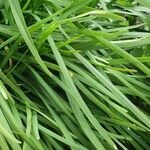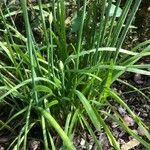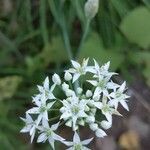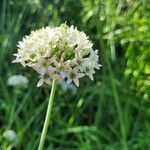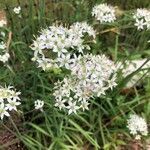Bulbs clustered, cylindric; tunic dull yellow to yellowish brown, reticulate to subreticulate. Leaves linear, shorter than scape, 1.5--8 mm wide, flat, solid, margin smooth. Scape 25--60 cm, terete, usually 2-angled, covered with leaf sheaths only at base. Spathe 2-or 3-valved, persistent. Umbel hemispheric to subglobose, laxly many flowered. Pedicels subequal, 2--4 × as long as perianth, bracteolate and several covered with a common bract at base. Perianth white; segments usually with green or yellowish green midvein; outer ones oblong-ovate to oblong-lanceolate, 4--7(--8) × 1.8--3 mm; inner ones oblong-obovate, 4--7(--8) × 2.1--3.5 mm. Filaments narrowly triangular, equal, 2/3--4/5 as long as perianth segments, connate at base and adnate to perianth segments; inner ones slightly wider than outer at base. Ovary obconical-globose, minutely tuberculate, without concave nectaries at base. Fl. and fr. Jul--Sep. 2 n = 16*, 24*, 32*.
An onion family plant. It is a herb which keeps growing year after year. It can be 40 cm high. It grows in clumps. These onions have rhizomes but no real bulbs. The leaves are long and grass like, and flat and solid. They are 15-30 cm long and about 5 mm wide. The young leaves are erect but the mature leaves bend gracefully down. The blades of the leaves are not folded length-wise, as are those of garlic and leek. Flowers are white. The flowers are produced at the top of a flower stalk which grows from the underground stem. The flower head is round due to the small flowers being on the same length stalks and arising from the same point. The flower stalk can be 45 cm long. A dense clump of plants is produced.
Bulb indistinct, narrowly ovoid to ovoid, 15-20 by c. 15 mm, several set on a rhizome. Protective bulbcoat-leaves several, broken up into netted fibres, light brown to brown. Foliage leaves 4-9, sub-erect or curved, flat, slighdy rounded or keeled on lower surface, 13-45 cm by 2-10 mm. Inflorescence umbellate. Flowers stellate; tepals white; stamens ± equalling tepals.
